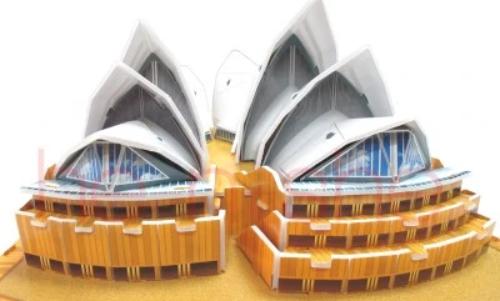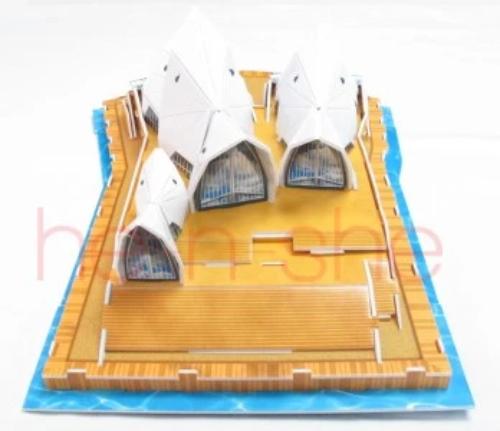58 PCS 3D Puzzle World's Architecture Series Sydney Opera House Australia 9814_2
58PCS 3D Puzzle - World's Great Architechure Series- Sydney Opera House Australia 9814-2
This is a very details 58PCS collectiable 3D Puzzle, one of the World's Great Architecture Series - Sydney Opera House Australia
World's Great Architecture-Sydney Opera House Australia
The Sydney Opera House is a multi-venue performing arts centre in Sydney, New South Wales, Australia. It was conceived and largely built by Danish architect Jørn Utzon, opening in 1973 after a long gestation that had begun with his competition-winning design in 1957.
Utzon received the Pritzker Prize, architecture's highest honour, in 2003. The Pritzker Prize citation stated:
There is no doubt that the Sydney Opera House is his masterpiece. It is one of the great iconic buildings of the 20th century, an image of great beauty that has become known throughout the world – a symbol for not only a city, but a whole country and continent.
The Sydney Opera House was made a UNESCO World Heritage Site on 28 June 2007. It is one of the 20th century's most distinctive buildings and one of the most famous performing arts centres in the world.
The Sydney Opera House is on Bennelong Point in Sydney Harbour, close to the Sydney Harbour Bridge. It sits at the northeastern tip of the Sydney central business district (the CBD), surrounded on three sides by the harbour (Sydney Cove and Farm Cove) and inland by the Royal Botanic Gardens.
Contrary to its name, the building houses multiple performance venues. The Sydney Opera House is among the busiest performing arts centres in the world, hosting over 1,500 performances each year attended by some 1.2 million people. It provides a venue for many performing-arts companies, including the four key resident companies Opera Australia, The Australian Ballet, the Sydney Theatre Company and the Sydney Symphony Orchestra, and presents a wide range of productions on its own account. It is also one of the most popular visitor attractions in Australia, with more than seven million people visiting the site each year, 300,000 of whom take a guided tour.
The Sydney Opera House is administered by the Sydney Opera House Trust, under the New South Wales Ministry of the Arts.
The Sydney Opera House is a modern expressionist design, with a series of large precast concrete "shells", each composed of sections of a sphere of 75.2 metres (246 ft 8.6 in) radius, forming the roofs of the structure, set on a monumental podium. The building covers 1.8 hectares (4.4 acres) of land and is 183 m (600 ft) long and 120 m (394 ft) wide at its widest point. It is supported on 588 concrete piers sunk as much as 25 m (82 ft) below sea level.
Although the roof structures of the Sydney Opera House are commonly referred to as "shells" (as they are in this article), they are in fact not shells in a strictly structural sense, but are instead precast concrete panels supported by precast concrete ribs. The shells are covered in a subtle chevron pattern with 1,056,006 glossy white- and matte-cream-coloured Swedish-made tiles from Höganäs AB, a factory that generally produced stoneware tiles for the paper-mill industry. though, from a distance, the shells appear a uniform white.
Apart from the tile of the shells and the glass curtain walls of the foyer spaces, the building's exterior is largely clad with aggregate panels composed of pink granite quarried at Tarana. Significant interior surface treatments also include off-form concrete, Australian white birch plywood supplied from Wauchope in northern New South Wales, and brush box glulam.
Of the two larger spaces, the Concert Hall is located within the western group of shells, and the Opera Theatre within the eastern group. The scale of the shells was chosen to reflect the internal height requirements, with low entrance spaces, rising over the seating areas and up to the high stage towers. The smaller venues (the Drama Theatre, the Playhouse, and The Studio) are located within the podium, beneath the Concert Hall. A smaller group of shells set to the western side of the Monumental Steps houses the Bennelong Restaurant. The podium is surrounded by substantial open public spaces, of which the large stone-paved forecourt area with the adjacent monumental steps is also regularly used as a performance space.
Performance venues and facilities
The Opera House houses the following performance venues:
- The Concert Hall, with 2,679 seats, is the home of the Sydney Symphony Orchestra and used by a large number of other concert presenters. It contains the Sydney Opera House Grand Organ, the largest mechanical tracker action organ in the world, with over 10,000 pipes.
- The Opera Theatre, a proscenium theatre with 1,507 seats, is the Sydney home of Opera Australia and The Australian Ballet.
- The Drama Theatre, a proscenium theatre with 544 seats, is used by the Sydney Theatre Company and other dance and theatrical presenters.
- The Playhouse, an end-stage theatre with 398 seats.
- The Studio, a flexible space with a maximum capacity of 400 people, depending on configuration.
- The Utzon Room, a small multi-purpose venue, seating up to 210.
- The Forecourt, a flexible open-air venue with a wide range of configuration options, including the possibility of utilising the Monumental Steps as audience seating, used for a range of community events and major outdoor performances. The Forecourt will be closed to visitors and performances 2011–2014 to construct a new entrance tunnel to a rebuilt loading dock for the Opera Theatre.
Other areas (for example the northern and western foyers) are also used for performances on an occasional basis. Venues at the Sydney Opera House are also used for conferences, ceremonies and social functions.






























